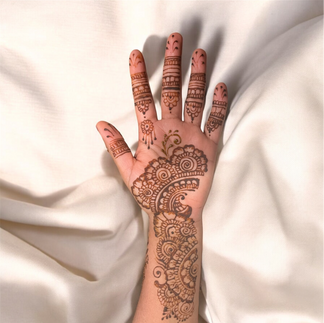Henna and Math
- Siya Gupta
- Nov 23, 2024
- 2 min read
How can Henna be used to teach and understand mathematical concepts?
Henna and math might be more similar than we all think. One is a centuries-old art form, painting intricate patterns on the skin. The other is a universal language, explaining everything from the orbit of planets to the flow of traffic. Yet, beneath their seemingly different surfaces, they share something profound: a deep relationship with complexity, symmetry, and structure.
Let’s talk fractals. If you’ve ever marveled at a henna design, you’ve seen fractals in action—those mesmerizing, self-repeating patterns that grow more detailed the closer you look. In math, fractals are described as infinitely complex figures, where a small section mirrors the whole. Henna mimics this with its repeating swirls, florals, and vines, each layer building on itself in a way that feels both intentional and infinite. It’s a visual representation of recursive functions, the same math behind natural phenomena like branching trees and river networks.
Then there’s symmetry—both an artistic and mathematical cornerstone. Most henna designs radiate with bilateral or radial symmetry. Imagine splitting a mandala down the middle or rotating it around a center point; the design remains unchanged. This mirrors group theory in abstract algebra, where mathematicians study symmetry in objects and transformations. Henna artists might not explicitly reference algebraic groups, but their hands intuitively solve the same puzzles of balance and proportion.
Now consider topology, the math of surfaces and shapes. Henna wraps around hands, fingers, and feet—contours far from flat or predictable. Yet, the designs flow effortlessly, adapting to curved spaces. This is where math’s study of manifolds comes into play, helping us understand how shapes and patterns behave on complex surfaces. A henna artist’s brush might as well be illustrating the principles of geometry on a living canvas.
And let’s not forget mathematical tiling. The repeating motifs in henna—diamonds, flowers, and waves—are practical examples of tessellations, where shapes fit together perfectly without gaps. This connects to the study of periodic tilings, used in everything from ancient Islamic art to the atomic structure of crystals.
But perhaps the most profound connection is how both henna and math invite us to explore complexity while creating beauty. Neither is limited to rigid rules; both leave room for creativity, interpretation, and the unexpected. The intricate loops and intersections in henna mimic the elegance of parametric equations, while the intuitive skill of the artist mirrors the mathematician's ability to navigate chaos and find order.
So, the next time you see henna, take a closer look. Hidden in its curves and dots is the beauty of complex math—alive, dynamic, and human. It’s proof that math isn’t just about numbers; it’s about patterns, connections, and the art of making sense of complexity. Henna, it turns out, is math brought to life, one intricate design at a time.
Here are some of my designs!:


















コメント